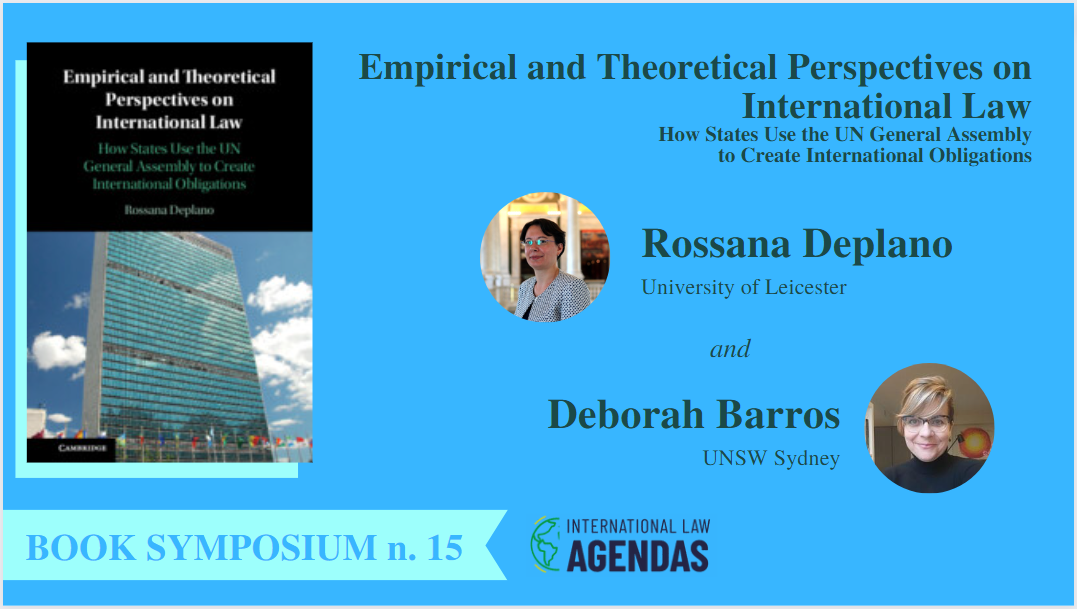How do UN General Assembly resolutions gain legal significance in state practice?
This is the main question explored by Dr. Rossana Deplano – Associate Professor at the University of Leicester’s (UK) Law School – in her book Empirical and Theoretical Perspectives on International Law: How States Use the UN General Assembly to Create International Obligations . Resolutions are non-binding documents, and the book reflects on why states (sometimes, but not always) commit to the legal principles contained in the resolutions. That is, when and why do countries follow through with the resolutions for which they vote if they are not legally required to? The answers are sought through a rich and in-depth empirical exploration of resolutions covering a period of over seven decades. The book’s findings are relevant for not just those interested in International Law but also in International Relations– as I will discuss further on.
The book is divided in five chapters plus an appendix detailing the research design and methods used for the empirical analysis. Chapter 1 offers an overview of the UN General Assembly (UNGA) and its main committees, finding a general shift from majority vote to consensus-building and highlighting flaws in functionalism to explain the autonomy between the UNGA and its member states. The next three chapters tackle resolutions’ legal significance in three moments. The main finding from looking at legal significance at the adoption stage (Ch. 2) is that a resolution’s text alone cannot determine its legal significance. Rather, political considerations are the key element explaining the variation in legal significance given to a resolution by each state. The next step is to look at resolutions’ legal significance in the context of countries’ domestic legal systems (Ch. 3), which Deplano points out as a gap in the literature pertaining to resolutions. The empirical analysis of almost 250 cases in 40 countries finds that the legal degree of resolutions in countries’ domestic law hinges not only upon each country’s own voluntary willingness to embrace the resolution but that resolutions are treated at a case-by-case basis. The empirical analysis of the legal significance of resolutions in international practice (Ch. 4) – international courts and tribunals – reaffirms Deplano’s warnings against generalizations, revealing that the attribution of legal significance by states and judges follows diverse paths. Resolutions are an important part of the development of international law but not in a deterministic way. Chapter 5 wraps up the book with the main message that the legal significance of UNGA resolutions should not be treated as a unidimensional concept, but rather as an intrinsically multifaceted one; also, that more conventional analyses largely underestimate the role of states in determining the legal significance and role of resolutions.
At this point, I should note by own academic position vis-à-vis the book and its topic. Prior to my PhD in Political Science, I taught Public International Law for eight years, and after the PhD my main area of research is International Relations, with a particular focus on International Organizations and global politics. As such, I read Deplano’s book not just with great interest but with this ‘mixed’ background in mind. Drawing from my current field of study, there is a particular phrase from Alexander Wendt that kept coming back to me while reading Deplano’s findings. Wendt is one of the most important authors in IR, and one of the fathers of Constructivism, an approach that conceives the international system as one built upon intersubjectivity, i.e., as socially constructed. One of his most famous works is entitled “Anarchy Is What States Make of It: The Social Construction of Power Politics” (1992). There, he directly challenged the (IR) Neorealist argument that anarchy is at the core of the international system. For the latter, the absence of any legitimate authority above the state makes all states focus on their own survival above anything else. Wendt’s contribution was to question this understanding. For him, anarchy was not a structure that was simply ‘given’, as if it existed like a natural law; rather, it was given meaning by interaction among states, hence the title “anarchy is what states make of it”.
To me, Deplano’s findings are an empirical reinforcement of Wendt’s arguments, which could be rewritten as “resolutions are what states make of it”. The UNGA was created by states for states. Thus, it should not come as a surprise that the character of resolutions – non-binding, through consensus (or not), with varying goals, etc. – emerged from intersubjective relations among states. From this lens, the ambiguity found in resolutions is not a mistake nor a failure. On the contrary: ambiguity is purposeful. It is designed to leave room for countries to adapt to the (possible) emergence of a law at their own pace, or not; or as a political quid pro quo among countries: “I’ll support your resolution (to which I am indifferent) if you support mine (which I really want to pass)”. Resolutions are legally ‘malleable’ because states have constructed them this way. Put differently, if states wanted all resolutions to be binding and unambiguous, they’d have made them this way.
Deplano’s book was a reminder of the frustration so many scholars have with academic silos that artificially separate overlapping research. In no way this is a criticism of Deplano’s research, but rather to my own acknowledgment that I could have easily missed this book simply because it would not show up on my ‘typical’ academic radar. (A simple example: this book does not appear on the publisher’s list for works in “International relations or International organizations”, something which is outside of an author’s control.) Deplano’s book is a reminder that the quest for parsimonious answers in social sciences can easily derail to oversimplification and essentially misleading conclusions – a lesson valid for both International Law and International Relations scholars.
By highlighting the ‘political’ life of resolutions before and after they come to life, the book is recommended for those interested in the fuzzy boundaries between International Law and International Relations, and international organizations. In the IR field, the research can also be of great use for Constructivists interested in norm creation and diffusion.
—
See Deplano’s response.
Also see Sayapin and Ridi‘s review.
-

Deborah Barros Leal Farias is a Brazilian-born Senior Lecturer at UNSW Sydney's School of Social Sciences, where she teaches Politics and International Relations.





